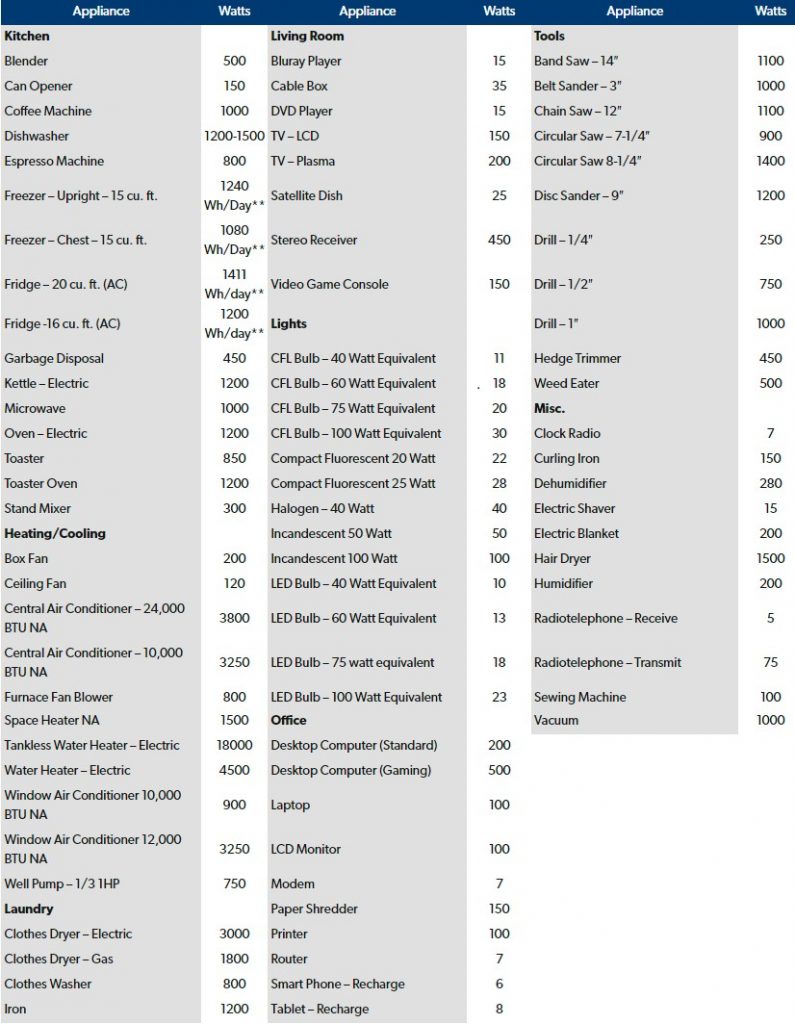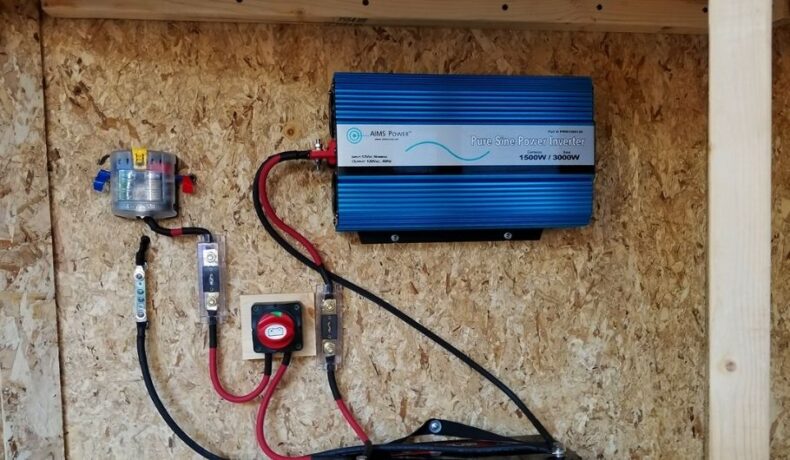The solar inverter is a vital part of a photovoltaic (PV) system used to power AC appliances. Whether you’re installing an inverter in your campervan, RV, boat, or home, it is important to know how to size your inverter correctly.
Installing the right size inverter will ensure your system works perfectly for its 20 – 25 years lifetime, and it’ll save you money in the process.
In this article, we’ll provide you with a detailed explanation with regards to sizing your inverter – from an expert’s point of view.
But first, we’ll explain what to consider when choosing your inverter and the formulas required to size it. Then we’ll provide you with some working examples.
Table of Contents
What Size Inverter Do I Need?
To choose an inverter, you need to consider 6 key factors:
- Maximum power rate.
- DC to AC ratio.
- Input voltage.
- Operating frequency.
- Inverter type.
- Output voltage.
Let’s delve into these factors a little more.
Maximum Power Rate
The maximum power rate means how much DC and AC power the inverter can handle. This value specified by the manufacturer needs to fit the design of your system and the load.
It’s vital to consider both DC and AC values. This ensures that the system does not supply or demand higher power rates that could trip the protection device of the inverter.
DC-AC Ratio
The DC-AC ratio is a sizing reference of the difference between the PV system nominal power and the AC output of the inverter. Solar inverters have a slightly higher DC power input capacity than their nominal AC output. This allows you to install an inverter with a nominal output below the nominal PV system size.
To select the inverter, installers take the required PV system size and divide it by the DC to AC ratio of their preference, usually estimated between 1.2 – 1.35. Keep in mind that the higher the DC-AC ratio, the higher the clipping losses of the system (DC power that is not converted to AC because the maximum AC output is exceeded)
The following table presents a list of some regularly used solar inverters and their maximum DC to AC ratios.
| Manufacturer | Product | Max AC Output (W) | Max DC Output (W) | AC to DC Ratio |
|---|---|---|---|---|
| SolarEdge | SE5000H-US | 5000 | 7750 | 7750/5000 = 1.55 |
| LG | D005KD1N111 | 5000 | 6600 | 6600/5000 = 1.32 |
| SMA Solar | Sunny Boy 5.0-US | 5000 | 7100 | 7100/5000 = 1.42 |
| Fronius | PRIMO 8.2-1 | 8200 | 12,300 | 12,300/8200 = 1.5 |
(Figure 1. Maximum DC to AC ratio of multiple solar inverters)
Input Voltage
Nowadays, solar inverters can handle very large voltage inputs. Some handle 600V DC while others go as high as 1000V DC, depending on the manufacturer and quality of the equipment. Choosing a system with a higher power input will let you install more panels in series, enjoying lower power losses and other benefits.
Output Voltage
The output voltage is the voltage delivered in AC. Single-phase inverters operate at 120V (or 240V for split-phase) in America. Larger inverters can deliver three-phase voltage at 208V or higher.
Operating Frequency
The operating frequency of an inverter should be matched to the nominal frequency of the devices that will be powered and/or the grid it will be connected to. Some countries operate at 50 Hz, but devices and appliances used in the U.S. operate at 60 Hz.
Inverter Type
There are usually three types of inverters available:
- String inverters
- Hybrid inverters
- Off-grid inverters
String inverters are the most regularly used type of inverters. These are straightforward inverters that are coupled with a string of solar panels, converting the DC-generated energy into AC. Commonly used for grid-tied applications.
Hybrid inverters allow you to fully control your PV system. These inverters store a percentage of the generated energy at your battery bank, send a portion to your home, and another fraction to the grid. With this inverter, all of the energy management is decided by you.
Off-grid inverters are designed to work on their own and they cannot be tied to the grid. These inverters are able to generate their own frequency to provide stability to the load and charge the batteries throughout the day while powering the home at night with stored energy from the batteries.
Which Formulas Do I Need To Size My Inverter?
Whether you’re sizing an inverter for an RV, campervan, boat, or home, these formulas will help with the task.
The first formula helps you calculate the daily energy consumption of the load.:

With the daily demand of the load, we can calculate the DC size of the PV system. For this calculation, we need to consider the Peak Sun Hours (PSH) in your state and a derating factor attached to DC losses and real-world operability for solar panels. A derating factor of 0.6 is intended for off-grid applications while a 0.7 factor is intended for grid-tied.

Finally, we need to calculate the size of your inverter. For this, we’ll use the DC power calculated before and the DC to AC ratio of the inverter.

In the following sections, we’ll size an inverter for a Campervan, RV, boat, and household. For these examples, we’ll assume 6.25 PSH which is the medium between the 5-7.5kWh/m2/day perceived in California and a 1.25 DC to AC ratio. Also, we will assume applications will be off-grid in all cases, except for the home.
What Size Inverter Do I Need For A Campervan?
In the following table, you’ll find the average daily energy consumption of a family campervan.
Daily Energy Consumption For A Campervan
| Appliance | Watt (W) | Hour usage per day (h) | Daily Consumption (Wh) |
|---|---|---|---|
| Small Fridge | 40 | 24 | 960 |
| Xbox/PS5 | 120 | 3 | 360 |
| LED TV | 59 | 5 | 295 |
| Blueray Player | 20 | 2 | 40 |
| LED Bulbs (x3) | 30 | 5 | 150 |
| Laptop | 100 | 3 | 300 |
| Coffee Maker | 1000 | 0.15 | 150 |
| Water Purifier | 60 | 1 | 60 |
| Blender | 500 | 0.1 | 50 |
| Total Daily Consumption (Wh) | 2,365 |
With this daily consumption, we can calculate the required PV system for the campervan by using Formula (2).

With a commercially available PV system of 635Wp (or above) for the Campervan, we can cover the usage and size of the inverter by using Formula (3) and the 1.25 DC to AC ratio.

A solar inverter of 508W is a perfect solution for this campervan. As such, the most appropriate option would be a 500W or 600W solar inverter.
What Size Inverter Do I Need For An RV?
As for RVs, the table below shows an estimated calculation of the power required for a family traveling in an RV.
Daily energy consumption Of An RV
| Appliance | Watt (W) | Hour usage per day (h) | Daily Consumption (Wh) |
|---|---|---|---|
| Small Fridge | 40 | 24 | 960 |
| Microwave | 800 | 0.5 | 400 |
| Plasma TV | 200 | 4 | 800 |
| Cellphones (x3) | 18 | 2 | 36 |
| LED Bulbs (x2) | 20 | 5 | 100 |
| Laptop | 100 | 4 | 400 |
| Coffee Maker | 1000 | 0.15 | 150 |
| Water Purifier | 60 | 1 | 60 |
| Blender | 500 | 0.1 | 50 |
| Water Heater | 1440 | 0.5 | 720 |
| Total Daily Consumption (Wh) | 3,676 |
With this daily consumption estimate, we can determine the size of the PV system with Formula (2):

With a commercially available PV system above 985Wp, the family in the RV can easily enjoy their trip, but they need to know the size of their solar inverter. For this, we will be using Formula (3):

The best size inverter for an RV would be 788W. However, you may find manufacturers selling 800W solar inverters or in some instances 1,000W models.
What Size Inverter Do I Need For A Boat?
Here’s the average daily energy consumption of a boat according to SeaHelp.
Daily energy consumption of a boat
| Appliance | Watt (W) | Hour usage per day (h) | Daily Consumption (Wh) |
|---|---|---|---|
| Refrigerator | 60 | 24 | 1440 |
| Pressurized water pump | 4,92 | 24 | 118.08 |
| Electric Toilet | 4,92 | 24 | 118.08 |
| Light P/hour in cabin | 180 | 4 | 720 |
| Music System | 84 | 4 | 336 |
| Cellphones Charging | 6 | 3 | 18 |
| Anchor Light | 30 | 8 | 240 |
| Underwater Lighting | 120 | 3 | 360 |
| Diesel Heating | 240 | 4 | 960 |
| Ice Maker | 348 | 4 | 1392 |
| Marine Washer/Dryer | 255 | 1 | 255 |
| Total Daily Consumption (Wh) | 5,957.16 |
A 5,957W daily load for the boat is more than the requirement for the Campervan and RV, but boats need more devices like electric toilets, lighting systems, and heating systems. With this daily consumption, we can calculate the PV system with Formula (2):

A 1.59kWp PV system will power the required devices to be comfortable onboard the boat, but you will likely find a commercially available PV system of 1.6kW. Now we can use Formula (3) to calculate the required solar inverter.

The best inverter size for a boat would be 1280W. However, this size is not easily found. Instead, you can use a 1300W model. This will handle the PV system and give you some room for expanding the system in case you need it.
What Size Inverter Do I Need For My Home?
According to the U.S. Energy Information Administration (EIA), the average U.S. home consumes monthly 893 kWh or 10,715 kWh yearly. This varies depending on the energy requirements by state, family members, and other factors. Here is a table of home appliances you can use to estimate the daily energy consumed in your home.

Considering the EIA information, we will use Formula (1) to calculate the daily power consumption for the average U.S. home.

With a 29.35kWh daily consumption, we can now estimate the size of the PV system required for the home, by using formula (2). In this case, we assume it is a grid-tied connected system:

Many homes can easily have energy independence with a 6.71kWp PV system. With Formula (3), we can now calculate the size of the inverter for this home.

The best inverter size for a home would be 5.36kW (5360W). However, this size is not sold on the market. Instead, you could buy a 5,500 – 6,000W inverter which would be sufficient for your home.
Final Thoughts
Sizing a solar inverter can be quite easy. By using these three simple formulas, you can calculate the daily consumption, size of the PV system, and size of the inverter for the required application.
As you can see, these formulas apply to anything: from RVs, campervans, boats, camping homes, your regular home, to practically any place that can have solar panels.
It is important to choose the right inverter since this will save you hundreds of dollars and ensure you’re using the proper inverter size.
If you want a more accurate result for your particular application, use the HSP for your state and the DC to AC ratio for an inverter you might be considering, this will let you know the right inverter size for you.

